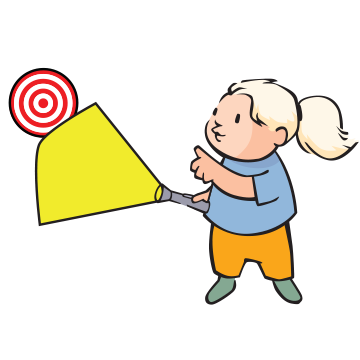Boston Children's Museum
308 Congress Street, Boston, MA 02210
617-426-6500
© Boston Children’s Museum 2025
Website Design by JackrabbitThis activity is a good follow-up to the Let Your Light Shine activity from this curriculum, and is a fun game to play. Activities like these help to reinforce a beginning understanding of the behaviors of light, and how those behaviors can be utilized and manipulated with different materials.
This activity works best in a dark space. Targets for the game can simply be objects in the room, or you can create a target that you move around the room. Draw a series of concentric circles, like a dart board target, with markers on a large piece of chart paper and post it in an area suitable for aiming at.

If you first tried the Let Your Light Shine activity from this curriculum, ask your students what observations they made when they played with light. What happened when they shone their light at a mirror? If you have the list of rules from that activity, bring it out and read the rules to your students. Tell them that you are going to challenge them to use everything they learned about light in those experiments by playing a game where they have to hit a target across the room with their beams of light.
Try to hit the target with your light!
After the first round, when each team has had three tries at hitting the first target, bring the whole group together. Did it get easier to figure out how to point their flashlight and where to face their mirror? Do any teams have tips for how to figure out where the spot of light will land before they turn on their flashlight? If the first round was a real challenge, give teams some more time to practice before playing again.
Try the game a few more times. For each new round, choose a new target in the room or move the target you have created and play again. Try smaller targets for more of a challenge, larger targets if teams are struggling. For an especially challenging new twist, have teams try to hit the target bouncing the light off of two mirrors.
Earth and Space science activities were developed with the support of NASA. This material is based upon work supported by NASA under grant award number NNX14AQ83G. Any opinions, findings, and conclusions or recommendations expressed in this material are those of the author(s) and do not necessarily reflect the views of the National Aeronautics and Space Administration (NASA).